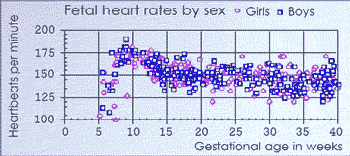What is Doppler Fetal Monitor

A Doppler fetal monitor is an ultrasound device for detecting heart beat of a fetus and provides simulation of the heart beat. It reports the heart beat rate in beats per minute and/or audio signals indicating the fetus heart beat.
A Doppler fetal monitor provides similar information as a fetal stethoscope; however a Doppler fetal monitor bounces ultrasound waves off of your baby's heart to produce sound and does not rely on the sound produced by the heart. Doppler auscultation is more sensitive and can pick up heart beats as early as 5-weeks into pregnancy; for fetal stethoscope, the fetus may have to grow 20 weeks before the heart beat is strong enough to be detected.
Doppler fetal monitor operators at either 2 or 3MHz. Both types would work well for heart rate detection; however the 3M Hz version works better during early stage of pregnancy, while the 2M Hz version works better for overweight mothers. 4MHz and 8 MHz probes are also available and they are for detection of blood flow in veins and arteries for assisting in the detection of peripheral vascular diseases.
Initially the fetus heart beats at 80-85 beats per minute (bpm), then it increase at about 3.3 beats per day until the ninth week peaking around 155 to 195 bmp. It would then gradually decrease to 120 to 170 bpm over the 40-week pregnancy. The following chart shows the fetus heart rates as a function of gestational age obtained during an experiment.

Do not overreact or get frustrated if you cannot hear the fetus heart beats especially during early pregnancy. This is common. When you can first hear the heart beat depends on several factors; if the mother is overweight, it may be more difficult. Furthermore, the probe must be positioned properly over the fetus. Furthermore only a trained professional is qualified to interpret the result.

